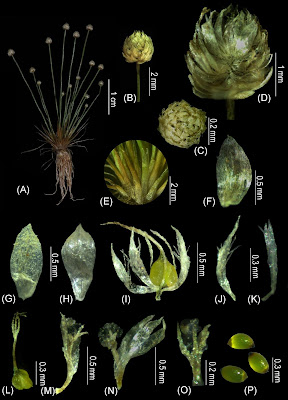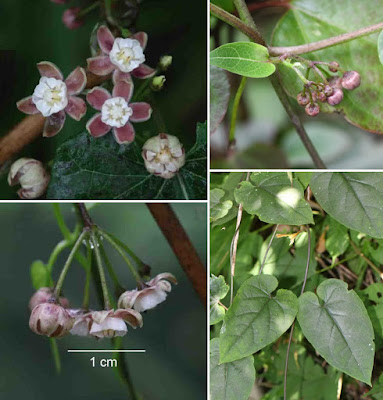[Most Recent Entries] [Calendar View]
Thursday, December 14th, 2023
| Time | Event | ||||
| 4:06a | [Botany • 2023] Stachys yingzuijieensis (Lamiaceae) • Molecular and Morphological Evidence for A New Species from Hunan, China
Abstract Stachys yingzuijieensis, a new species from western Hunan, China, is described and illustrated. Molecular phylogenetic analyses based on three nuclear ribosomal DNA loci (ETS, ITS and 5S-NTS) recovered S. yingzuijieensis within the Stachys clade and as a sister group of S. arrecta. The two species can be easily distinguished by the morphology of lamina, corolla and nutlet. A key to all species of Stachydeae from China is also provided. Key words: Eurystachys clade, Lamioideae, micromorphology, Stachydeae, taxonomy Stachys yingzuijieensis L.Wu & Y.P.Chen, sp. nov. Diagnosis: Stachys yingzuijieensis is most closely related to S. arrecta, but differs in its lamina oblong to elliptic-lanceolate (vs. cordate) with margin crenulate (vs. coarsely serrate), corolla white (vs. pink with purple spots) with tube included in calyx (vs. exerted from calyx) and nutlet surface smooth (vs. verrucate). Etymology: The specific epithet is derived from the type locality of the new species, i.e. the Yingzuijie National Nature Reserve in western Hunan Province, China. Chinese name (assigned here): yīng zhuǐ jiè shuǐ sū (鹰嘴界水苏). Ling Xue, Jia-Hua Cai, Min Zhan, Xiao-Ping Li, Lei Wu and Ya-Ping Chen. 2023. Molecular and Morphological Evidence for A New Species of Stachys (Lamiaceae) from Hunan, China. PhytoKeys. 236: 121-134. DOI: 10.3897/phytokeys.236.112741 | ||||
| 8:57a | [Paleontology • 2023] Mobulavermis adustus • A large pelagic lobopodian from the Cambrian Pioche Shale of Nevada, USA
Abstract Lobopodians are an iconic and diverse group of animals from the Cambrian, which alongside radiodonts, present an important window into the evolution of arthropods and the development of Paleozoic ecosystems. Of these, a rare few species outside of Radiodonta possess lateral swimming flaps. The recent discovery of Utahnax provided much-needed insight into the evolution of swimming flaps, suggesting that the ventrolateral flaps of Kerygmachela evolved independently from other flap-bearing lobopodians and radiodonts. Here a new pelagic lobopodian species is described, Mobulavermis adustus new genus new species, the first lobopodian to be reported from the Cambrian-age Pioche Shale of Nevada. Mobulavermis adustus was large and possessed more ventrolateral flap pairs than any other known lobopodian or radiodont. It is found to be a close relative of both Kerygmachela and Utahnax, allowing the establishment of the new lobopodian family Kerygmachelidae new family. In addition, an indeterminate euarthropod fossil from the Pioche Formation is described in brief, and the recently described Chengjiang species Parvibellus avatus Liu et al., 2022, thought to have been related to the “gilled lobopodians,” is reinterpreted as a juvenile siberiid lobopodian. Systematic paleontology Superphylum Panarthropoda Nielsen, Reference Nielsen1995 Family Kerygmachelidae new family Type genus: Kerygmachela Budd, 1993. Other taxa included: Utahnax Lerosey-Aubril and Ortega-Hernández, 2022, Mobulavermis n. gen. Diagnosis: Lobopodians with lobopod-derived ventrolateral swimming flaps and lacking dorsal flaps or setal blades; trunk elongate, roughly cylindrical, and annulated; paired frontal appendages large and raptorial. Genus Mobulavermis new genus Type species: Mobulavermis adustus, by monotypy. Etymology: From Mobula, the genus name of extant manta rays and devil rays, drawing comparison to the elongate flexible caudal spines and broad swimming flaps of Mobula rays, which resemble the outline of the new taxon, combined with the Latin vermis, meaning “worm.” Mobulavermis adustus new species Anomalocaridid gen. indet. sp. indet.; Lieberman, 2003; p. 683, fig. 6.4. indeterminate anomalocaridid; Lerosey-Aubril and Ortega-Hernández, 2022; p. 15. Diagnosis: Lobopodian with vermiform body terminating in an elongate, flexible caudal spine; numerous broad, densely packed, lobopod-derived ventrolateral body flaps strongly overlapping successively; posterior ventrolateral body flaps decreasing in size linearly toward base of caudal spine until becoming flush with trunk; ventrolateral body flap posterior margins convex, anterior margin begins perpendicular to body wall before gradually curving posteriorly. Occurrence: Pioche Formation, Combined Metals Member (Cambrian Series 2, Stage 4, Nephrolenellus multinodus Biozone), Lincoln County, Nevada; .... Etymology: From the Latin adustus, meaning “burnt,” “singed,” or “sun-burnt,” in reference to the dramatic yellow, red, and black coloration of the two known specimens and to the arid conditions of the type locality. Christian R.A. McCall. 2023. A large pelagic lobopodian from the Cambrian Pioche Shale of Nevada. Journal of Paleontology. First View. DOI: 10.1017/jpa.2023.63 Non-technical Summary: Lobopodians are an iconic group of animals from the Paleozoic that includes Hallucigenia and Opabinia, as well as living animals such as tardigrades and velvet worms. They would also eventually give rise to the first arthropods by developing a hard, sclerotized exoskeleton. During the Cambrian, a rare subset of lobopodians possessed large swimming flaps, sometimes alongside ventral walking limbs. A new, large-bodied pelagic lobopodian from the Cambrian of Nevada is described, possessing more swimming flaps than any other lobopodian or radiodont. | ||||
| 12:47p | [Botany • 2021] Eriocaulon sanjappae (Eriocaulaceae) • A New Species from the southern Western Ghats, India
Abstract A new species of Eriocaulaceae, Eriocaulon sanjappae is described from the southern Western Ghats, India. It is morphologically close to E. rajendrababui, in having glabrous, connate male sepals and non-appendaged seeds but differs by its smaller leaves and peduncles, hemispherical heads, oblong involucral bracts, hairy receptacles, non-glandular male petals, hairy female sepals and elliptic, brownish-yellow seeds. A detailed description, illustration and photographic images are provided. The morphological differences with relevant species are discussed. The status of the new species is provisionally assessed here as ‘Critically Endangered' (CR) according to IUCN Red List Categories and Criteria. Keywords: Chandanathode, Critically Endangered, Eriocaulon rajendrababui, Eriocaulon sanjappae, Wayanad district Santhosh Nampy and Mannar Kandy Akhil. 2021. Eriocaulon sanjappae (Eriocaulaceae), A New Species from the southern Western Ghats, India. Nordic Journal of Botany. DOI: 10.1111/njb.03311 | ||||
| 1:26p | [Botany • 2021] Cynanchum hubeiense (Apocynaceae: Asclepiadoideae) • A New Species from Hubei, China
Abstract Cynanchum hubeiense Wen. B. Xu, B.S. Xia & J.Y. Shen (Apocynaceae), a new species from Luotian County, Hubei Province, China, is described and illustrated. It is similar to C. callialatum Buch.-Ham. ex Wight, C. decipiens Schneid., C. brevipedunculatum J.Y.Shen and C. longipedunculatum M.G.Gilbert & P.T.Li, but differs from them by slightly angulate follicles, the shorter peduncle, corolla white to reddish, corolla lobes ovate, planar, stems without two leaflike stipules per node, and stems sparsely puberulent. Photographs, distribution, comparison with related species, and conservation assessment are provided for this rare vine species. Keyword: Asclepiadeae, Cynanchum callialatum, C. decipiens, C. brevipedunculatum, C. longipedunculatum Cynanchum hubeiense Wen B. Xu, B. S. Xia & J. Y. Shen, sp. nov. 湖北豹藥藤 Diagnosis: Cynanchum hubeiense is allied to C. callialatum, C. decipiens, C. brevipedunculatum, and C. longipedunculatum, but can be distinguished by several morphological features (Table 1), including follicles slightly angulate (vs. with 2 wings especially prominent at tip in C. callialatum), corolla lobes ovate (vs. oblong in C. callialatum, C. decipiens, C. brevipedunculatum, and C. longipedunculatum), branchlets sparsely puberulent (vs. pubescent along a single line in C. callialatum, C. decipiens, C. brevipedunculatum and C. longipedunculatum), and absence of stipules (vs. two leaflike-stipules per node in C. decipiens, C. brevipedunculatum and C. longipedunculatum), peduncle 5–9 mm (vs. 40–90 mm in C. decipiens, 18–22 mm in C. brevipedunculatum, 60–90 mm in C. longipedunculatum). Distribution & habitat: At present, C. hubeiense is only known from the type locality. The species is found beside the road of Bodaofeng Mountain, it is surrounded by dense mixed woods, at an elevation of about 1,360 m. The common companion species are Oplismenus undulatifolius (Ard.) P.Beauv., Commelina communis L., Polygonum nepalense Meisn., Hylodesmum podocarpum (DC.) H.Ohashi & R.R.Mill, Patrinia scabiosifolia Fisch. ex Trevir., and Lysimachia clethroides Duby. Etymology: The new species is currently only known from the Hubei Province, China, thus the specific epithet “hubeiense” was chosen. The Chinese name is “湖北豹 藥藤” (hú běi bào yào téng), which means the vine is poisonous. Wen-Bin Xu, Bo-Shun Xia, Jin-Qing Wu, Yu-Xing Chen and Jian-Yong Shen. 2021. Cynanchum hubeiense (Apocynaceae), A New Species from Hubei, China. Taiwania. 66(1); 53-56. DOI: 10.6165/tai.2021.66.53 taiwania.ntu.edu.tw/abstract/1733 | ||||
| 1:32p | [Herpetology • 2023] Trimeresurus ayeyarwadyensis • A New Species of Pit-viper (Serpentes: Viperidae) from the Ayeyarwady and Yangon regions in Myanmar
Abstract In a genomic study by Chan and colleagues, pit-vipers of the Trimeresurus erythrurus–purpureomaculatus complex from the Ayeyarwady and Yangon regions in Myanmar were demonstrated to be a distinct species based on robust population genetic and species delimitation analyses. Here, we provide morphological characterizations and a formal description of those populations as a new species. The new species, Trimeresurus ayeyarwadyensis sp. nov., is most closely related to T. erythrurus and T. purpureomaculatus and shares morphological characteristics with both of those species. Some specimens of T. ayeyarwadyensis sp. nov. have green dorsal coloration and no distinct dorsal blotches (a trait shared with T. erythrurus but not T. purpureomaculatus), while others have dark dorsal blotches (a trait shared with T. purpureomaculatus but not T. erythrurus). The distinct evolutionary trajectory of the new species, coupled with the lack of obvious morphological differentiation, represents a classic example of the cryptic nature of species commonly found in the Trimeresurus group of Asian pit-vipers and underscores the need for data-rich analyses to verify species’ boundaries more broadly within this genus. Key words: Cryptic species complex, mangrove pit-viper, morphology, snake, systematics, taxonomy
Trimeresurus ayeyarwadyensis sp. nov. Vernacular name: Ayeyarwady pit viper Diagnosis: Trimeresurus can be distinguished from all other Asian pit-vipers by the condition of the first infralabial and nasal scale, which are at least partially fused. The new species can be diagnosed from other species of Trimeresurus by the following combination of characters: in both sexes (n = 19), 23–25 dorsal mid-body scale rows (mean 24.3 ± 0.97), 17 scale rows just anterior to vent (rarely 15 or 16) and body scales distinctly and sharply keeled; in males (n = 8), 150–170 ventral scales (mean 160.6 ± 5.6), 71–76 subcaudal scales (mean 73 ± 1.8); a minimum of 9–11 scales between supraoculars (mean 9.9 ± 0.6); between 5–9 scales touching the subocular scale (not counting pre- and post-oculars; mean 6.9 ± 0.9); supralabials 9–12 (mean 10.4 ± 0.8). In females (n = 11), 157–174 ventral scales (mean 165.1 ± 4.9), 52–58 subcaudal scales (mean 55 ± 2.1); a minimum of 10–12 scales between supraoculars (mean 10.8 ± 0.9); between 5–8 scales touching the subocular scale (not counting pre- and post-oculars; mean 6.5 ± 0.8); supralabials 10–12 (mean 10.9 ± 0.6). Distribution: Trimeresurus ayeyarwadyensis sp. nov. occurs at Hlawga Park in the Yangon Region and Pyapon and Myaungmya districts in the Ayeyarwady Region. The northern and western limits of its distribution likely lie somewhere in between the Myaugmya and Pathein districts in the Ayeyarwady Region. Southward, it could occur in mangroves in Mon State. Natural history: In the Pyapon and Myaungmya districts in the Ayeyarwady Region, snakes were found in mangrove forests, whereas at Hlawga Park in the Yangon Region, snakes were found in forested habitats around a lake that is not connected to any mangrove system. In that regard, T. ayeyarwadyensis sp. nov. is more similar to T. erythrurus as opposed to T. purpureomaculatus, which is a strict mangrove-associated species. Etymology: The specific epithet “ayeyarwadyensis” refers to the Ayeyarwady River (= Irrawaddy River), which is the largest and one of the most important rivers in Myanmar. The river forms an expansive delta that is bounded by the Pathein River to the west and the Yangon River to the east. These rivers and their associated basins also mark the westernmost and easternmost distribution boundaries of T. ayeyarwadyensis sp. nov. Kin Onn Chan, Shahrul Anuar, Ananthanarayanan Sankar, Ingg Thong Law, Ing Sind Law, Rasu Shivaram, Ching Christian, Daniel G. Mulcahy and Anita Malhotra. 2023. A New Species of Pit-viper from the Ayeyarwady and Yangon regions in Myanmar (Viperidae, Trimeresurus). ZooKeys. 1186: 221-234. DOI: 10.3897/zookeys.1186.110422 |
| << Previous Day |
2023/12/14 [Calendar] |
Next Day >> |

















